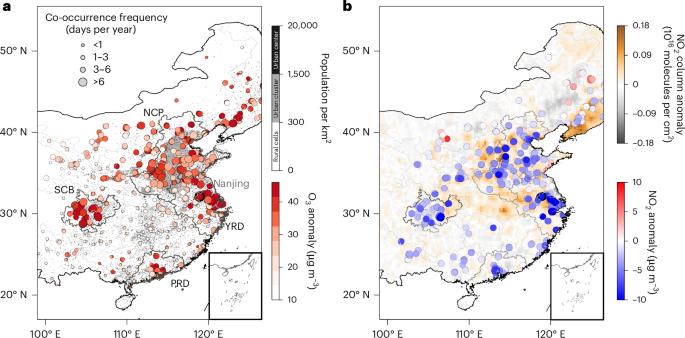Urban meteorology–chemistry coupling in compound heat–ozone extremes
引用次数: 0
Abstract
Heatwaves and ozone (O3) pollution threaten human and ecosystem health, with their compounding effects particularly severe in cities. While ground-based observations are indicative of urban O3 pollution during heatwaves, limited vertical insights into the intensified and prolonged O3 pollution hinder a comprehensive understanding of the underlying mechanisms and mitigation strategies. Here, leveraging airship vertical measurements and meteorology–chemistry coupled modeling, we reveal that heatwave-reinforced turbulence redistributes precursors vertically, altering photochemical stratification and accelerating O3 production both at the surface and aloft over megacities in China. Stringent emission controls targeting nitrogen oxides could mitigate the heatwave-exacerbated O3 extremes by narrowing the vertical disparity of photochemical sensitivity. Although heatwaves are projected to intensify, emission reductions due to China’s carbon neutrality pledge could alleviate urban O3 pollution by 41–47% during heatwaves and help tackle the dual challenges of air pollution and global warming while enhancing the climate resilience of city clusters. Heatwaves and ozone pollution pose compounded risks to urban health, but limited vertical insights have hindered understanding of their interaction. Using airship observations and model simulations, this study reveals that heatwaves worsen urban ozone pollution by vertically redistributing precursors, while emission reductions could mitigate heat–ozone extremes in a warming climate.

复合热-臭氧极值的城市气象-化学耦合
热浪和臭氧污染威胁着人类和生态系统的健康,其复合效应在城市尤为严重。虽然地面观测表明热浪期间存在城市臭氧污染,但对臭氧污染加剧和持续时间有限的垂直洞察妨碍了对潜在机制和缓解战略的全面了解。利用飞艇垂直测量和气象-化学耦合模型,我们揭示了热浪增强的湍流在垂直方向上重新分配了前体,改变了光化学分层,加速了中国大城市地面和高空的O3生产。严格的氮氧化物排放控制可以通过缩小光化学敏感性的垂直差异来缓解热浪加剧的O3极端。尽管预计热浪将加剧,但中国碳中和承诺所带来的减排可使热浪期间的城市臭氧污染减少41-47%,有助于应对空气污染和全球变暖的双重挑战,同时增强城市群的气候适应能力。热浪和臭氧污染对城市健康构成了复杂的风险,但有限的垂直视角阻碍了对它们相互作用的理解。利用飞艇观测和模式模拟,本研究揭示了热浪通过垂直重新分配前体而加剧城市臭氧污染,而减排可以缓解气候变暖中的热臭氧极端现象。
本文章由计算机程序翻译,如有差异,请以英文原文为准。
求助全文
约1分钟内获得全文
求助全文

 求助内容:
求助内容: 应助结果提醒方式:
应助结果提醒方式:


